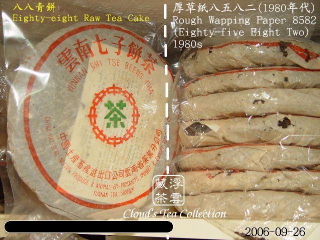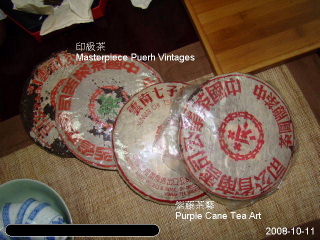 After setting up the Cloud's Tea Diary, Cloud often receives e-mails and private messages with questions related to Puerh tea. Those questions are good questions. Beginners may also have similar doubts when they start their Puerh tea journeys. Thus, Cloud decides to gather these Q&As to the Cloud's Tea Diary so that the later comers may make reference to my answers.
After setting up the Cloud's Tea Diary, Cloud often receives e-mails and private messages with questions related to Puerh tea. Those questions are good questions. Beginners may also have similar doubts when they start their Puerh tea journeys. Thus, Cloud decides to gather these Q&As to the Cloud's Tea Diary so that the later comers may make reference to my answers.
-----------------------
A Puerh tea lover, AY, asked, "How do I store the 1990's Puerh tea cakes? How about the newly made young tea cakes? Can they be stored together?"
In fact, in relation to how to store Puerh tea at home, Cloud has already put down the details as an appendix in the First Step to Chinese Puerh Tea (hardback edition) titled "How to Store Puerh Tea at Home (Part I)" and "How to Store Puerh Tea at Home (Part II)" in the Art of Tea magazine issue No. 3. If you are interested in learning the details, please read these relevant articles. Cloud did not intend to replace these articles by this diary. This diary is an interactive way to further elaborate based upon the articles.
If the teas are not exactly the same kind, they should be stored separately
This is again one of the basic principles of the Five Principles mentioned in "2009-08-29 Storage (1) - Principles & Cardboard Box", the fifth point - No odor.
The aroma of the old or aged tea cake by dry storage is what we called the aged aroma. If it is a wet storage Puerh tea, the aroma may be referred as aged earthy aroma (Chinese: 陳倉味). If it is a drily stored young tea cake without many years of aging, the fragrance of such is what we called raw and green aroma.
Obviously, you may notice that there are huge differences between the aromas of these Puerh, no matter whether they are dry, wet, aged or young. Although all of them are named as Puerh tea generally, their natures of aroma are very different. If they are stored together, their aromas will be "mixed" (or, in fact, contaminated) together. Generally speaking, the astringent green aroma of young raw Puerh is stronger than the gentle and elegant aged aroma. Thus, in most of situations, the aged tea cakes will be affected by the young raw astringent smell rather than the young raw tea cakes absorbing the well aged elegant aroma from the old tea cakes.
What tea lovers have to pay attention is that: Tea will absorb odor easily. Odor means the pleasant/unpleasant smell not being the original fragrance of the tea itself. In this situation, it is not the case as mentioned in "2009-08-29 Storage (1) - Principles & Cardboard Box" that the odor referring to the aromas of the ripe Puerh and the raw Puerh. It refers to the different aromas of old tea cakes and young raw tea cakes. In relation to aged tea cakes, the raw, green and astringent smell released from the young tea cakes is a kind of odor to the old tea cakes.
It is not difficult to understand. As long as the types of aroma are different, these Puerh tea cakes should be stored separately.
Old Tea Cakes, Aged Enough? Do They Still Need Aging?
Without doubt, newly made young raw tea cakes need aging. Beginners, tea lovers and tea connoisseurs working hard for hoarding their own tea cakes are to store their own well aged raw tea cakes.However, what if the raw tea cakes have reached their maturity (e.g. the Masterpiece Puerh Vintages, Aged Seven-son Tea Cake Vintages, etc.)? For these Puerh teas, there is no need for further great improvement on aging. How should we keep them? Shall we put them under the further quick aging environments? Or, shall we slow their aging process down so as to preserve their peak tastes?
For aged tea, tea connoisseurs will adopt the latter way treating their aged teas in order to prevent taste weakening. These well aged vintages should not further contact with air extensively.
Lastly, Cloud would like to reply the question. Before doing so, however, the question needs to be further sub-divided into, "(1) Do these 1990's tea cakes need further aging? (2) Are these 1990's tea cakes good enough to appreciate?"
- If these 1990's tea cakes need several to 10 more years for further aging, the storage conditions will be similar to that of storing young raw Puerh tea cakes according to the Five Principles;
- If these 1990's tea cakes have reached their good status for appreciation (due to the mild wet storage), there is no reason for further storage. What you need to do is to break the whole tea cake up and then put the chipping off pieces into a suitable container for accumulating their flavors. When you want to have a nice brew, brew them then. There is no need to save because the purpose of buying tea and hoarding tea for many years is to drink the tea at its climax stage. Since they have already reached their good tastes, sealing them for preserving the taste is the appropriate way to handle these well aged tea cakes.
30 September 2008 wrote in Chinese
18 November 2008 translated into English
Cloud (Hong Kong)
Back to: By Category reading mode
Cloud's Tea Diary
http://www.cloudsteacollection.com/html/weblog/weblog_e.html
Cloud's Tea Collection - Private Tea Album
http://www.cloudsteacollection.com